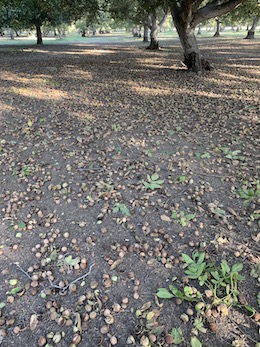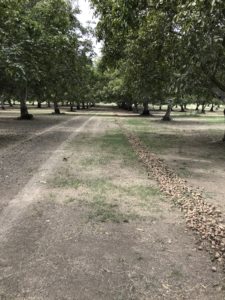
This past week was walnut week – marked by the hum of the machinery and the clouds of dust emanating from the orchard and full trailers of nuts. We aren’t completely done with our 2021 walnut harvest, but we’re almost there, having harvested two of our three walnut varieties and most of our 12 acres of trees.


Before sweeping into windrows – After sweeping into windrows
The previous week, the orchard and machinery had been prepped for harvest, meaning we stopped irrigating, the cover crop was mowed, and the equipment was looked over. We use the same equipment recently to harvest our almonds so everything was almost ready to go, but still needed some tweaks and fixes.
The three pieces of machinery we use are, in order of use:
1. A shaker – shakes the nuts off the trees
2. A sweeper – sweeps the nuts into neat windrows
3. The harvester – gets the nuts off the ground and into a trailer. It also removes some leaves, sticks, and rocks
If you want to see how these machines work, check out this video.
After the almonds or walnuts are in the trailer, we send them to a huller (you rarely see the hulls once a walnut is off the tree but it’s a smooth, thick green layer covering the brown wrinkly shell) then a sheller and then we get them back. We keep only a small amount of in-shell walnuts to sell that way. Ideally the walnuts will go to a facility that does both the hulling and the shelling. We had been sending our walnuts to a local company, but they’ve closed, so we need to change plans this year.
Described above is the process for almost all walnut growers in California. Some growers have their own hullers and/or shellers and some growers sell their nuts to a buyer (instead of directly to the customer like we do) so they never see them again after they leave the farm. But there are a few things about our walnut harvest that are worth noting!
The varieties we grow: Six varieties account for over 85% of all CA walnut production: Chandler, Hartley, Howard, Tulare, Serr, and Vina with Chandler making up over a third of all walnuts. We don’t grow any Chandler; our orchard was planted before that variety became popular, and some trees probably were planted before Chandler was released! All of our trees are the ones that came with the property and haven’t been replaced. Most of our trees are Serr with some Tehama and Hartley. Hartley mature slower and have about two more weeks till harvest.
Cover-cropping: many orchards are managed to have bare soil free of any weeds or plants. Not us. We keep our orchard floors covered with a cover crop for soil health, erosion control, water retention, and dust control during harvest. Cover cropping is becoming more accepted in the nut world and we hope that more growers adopt the practice.
When we harvest: we harvest a little later than the average walnut grower, who is selling into a commodity market that prizes nuts that are as light colored as possible. These nuts are less mature and need to be dried. We leave ours on the tree longer, to age a bit more and dry naturally. As a result, they’re darker colored and (in our opinion) have a better taste.
Nuts require a lot of work and special equipment to grow and process, especially for really small producers (in the nut world) like us. And it’s all over so fast – all the nuts are shaken off a tree with a few shakes, and before you know it, the whole orchard is nut-free. Processing takes a while (thanks in part to FDA and Homeland Security rules to control insect pests and foodborne illnesses) so it’ll be a bit longer still until we have our walnuts back to share with you. But the step of getting them off the trees is done!
– Elaine Swiedler, CSA Manager
